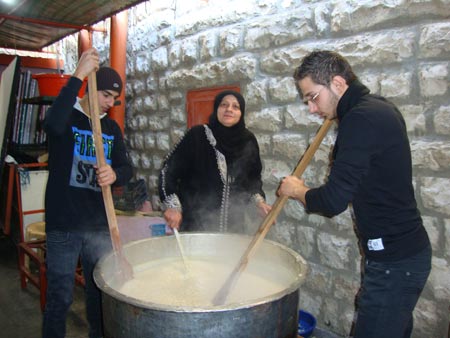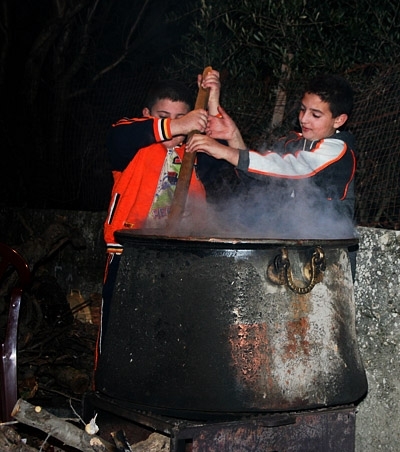Hriseh: An Annual Dish with the Essence of Ashura

After the elegy, Hiam Ajami, from the southern town of Nabatiyeh, began her preparations to cook Hriseh; her annually dish which she presents for the love of Imam Hussein. Hiam happily expressed her love for Imam Hussein, and proudly talked about her family's participation in cooking Hriseh, even her brother Mohammed, who arrived to Lebanon that morning from Africa with his family. He came to share with his sister this special day commemorating the memory of Imam Hussein, and all together the men women, children, neighbors and friends took turns in stirring the Hriseh.

When asked about her story with this traditional dish, Hiam said, "Since I was a child, I have been helping in cooking Hriseh in Ashura, and although now I cook regular food and distribute in Ashura, but Hriseh remains the most important dish to share on the memory of Imam Hussein. I believe that if I don't cook Hriseh, then I wouldn't have done anything to commemorate the memory of Imam Hussein."
Um Ali, from south Lebanon but living in Beirut, who has been cooking Hriseh in Beirut for about 20 years, said in an interview with moqawama.org, "Usually on the tenth of Muharram, families cook Hriseh, this is a day of grief for all of us because we are sharing Imam Hussein his suffering, and when we cook Hriseh we remind the world of Imam Hussein."
Moreover, Um Nazih from the southern village of Bint Jbeil narrated her story about cooking Hriseh in Ashura.
"I have been cooking Hriseh since before I remember, I used to help my mother when I was little girl, and we used to distribute portions to participants during the days of Ashura", Um Nazih stated while stirring a huge pot of Hriseh.

"After I got married and moved to my husband's town, I bought a rooster, fed and took care of it for a whole year, reserving it for Ashura", she added.
Furthermore, she described how this rooster was spoiled by the people in the village, wherever it walked between the neighbors' houses looking for left overs.
"Usually the people force out others' chickens and poultry, but this rooster was spoiled by everyone and all the people of the village offered it food until it has become, without exaggeration, as big as a lamb", Um Nazih said.
"All the villagers knew that this rooster was raised to be cooked for Ashura's Hriseh, which is offered for the love of Imam Hussein", she also stated.
The said stories stand as evidence, from different areas in Lebanon, of the important indications of Hriseh cooking among people. In the villages around the big cities, Hriseh is cooked, and people participate either by providing the ingredients (wheat, meat and chicken) or by providing the fire and stirring the Hriseh on a low heat so it won't burn.

This kind of education module has been criticized by the West and some of those who accuse these people of being old fashioned members of the society. However, the Western education does not examine the behavior of this education module, which has been inherited from generation to generation. This module has the ability to carry the values and concepts of Ashura throughout those generations, and therefore reviving the uprising of Imam Hussein.
Apart from Lebanon, Hriseh is known for other countries as well, and that is linked to a long Islamic tradition expressing loyalty to Imam Hussein in several places. For example, this habit existed a long time ago in Iraq, especially among the Shiite community.
In this context, the Iraqi historian Muthana Gharbawi says that since the incident of Karbala, Hriseh has been the favorite food for Iraqis in the days of Ashura, and is distributed among neighbors to commemorate the soul of Imam Hussein. He added that Hriseh became a famous dish in the Arab and Islamic world and is called by many names in different countries, and the difference in the ingredients depends on the location or the country. He added that historical dish is famous in Karbala and Euphrates, as well as the areas on the borders with Iran.
Also, Hriseh goes back in history since the year 61 AH (After hijra of Prophet Mohammad), the year in which Imam Hussein was martyred with his companions and family members. Hriseh started when the women and children of Imam Hussein's household were held captives in Damascus under Yazid's command.
The women and children were hungry and exhausted along the way, so Sayyeda (Lady) Zeinab looked for something to help the children in the place where they were stationed, in the Khirba. Because she was responsible for the captives, women and children, she gathered the very few grains of wheat she found in that place, and cooked them to stop their hunger.
Source: moqawama.org




